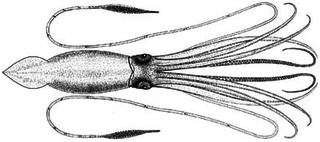
The giant squid is a species of deep-ocean dwelling squid in the family Architeuthidae. It can grow to a tremendous size, offering an example of abyssal gigantism: recent estimates put the maximum size at around 12–13 m (39–43 ft) for females and 10 m (33 ft) for males, from the posterior fins to the tip of the two long tentacles. The mantle of the giant squid is about 2 m long, and the length of the squid excluding its tentacles rarely exceeds 5 m (16 ft). Claims of specimens measuring 20 m (66 ft) or more have not been scientifically documented.

The Bolitaeninae are a subfamily, in the family Amphitretidae, of small, common pelagic octopuses found in all tropical and temperate oceans of the world. The taxonomy of this taxon is not entirely certain; recent research suggests just two genera exist, Bolitaena and Japetella, both of which are thought to be monotypic by some authorities and under this view, the family would represent two very similar species: Bolitaena pygmaea and Japetella diaphana. However, currently a second species of Bolitaena, B. massyae is also recognised.

Tremoctopus is a genus of pelagic cephalopods, containing four species that occupy surface to mid-waters in subtropical and tropical oceans. They are commonly known as blanket octopuses, in reference to the long, transparent webs that connect the dorsal and dorsolateral arms of the adult females. The other arms are much shorter and lack webbing.
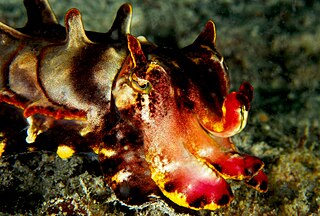
Metasepia pfefferi, also known as the flamboyant cuttlefish, is a species of cuttlefish occurring in tropical Indo-Pacific waters off northern Australia, southern New Guinea, as well as numerous islands of the Philippines, Indonesia and Malaysia.
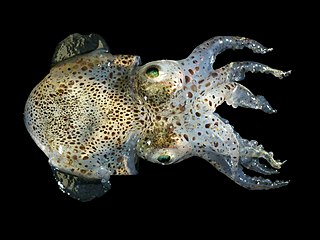
Sepiola atlantica, also known as the Atlantic bobtail, is a species of bobtail squid native to the northeastern Atlantic Ocean and the Mediterranean Sea.
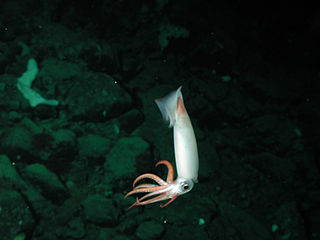
The Gonatus Onyx is in the class Cephalopoda, in the phylum Mollusca. It is also known as the Clawed arm hook squid or Black-eyed squid. It got these names from the characteristic black eye and from its two arms with clawed hooks on the end that extend a bit further than the other arms. It is a squid in the family Gonatidae, found most commonly in the northern Pacific Ocean from Japan to California. They are one of the most abundant cephalopods off the coast of California, mostly found at deeper depths, rising during the day most likely to feed.
Eledone massyae, the combed octopus, is a small benthic octopus found off the Atlantic coasts of southern South America, particularly Argentina and southern Brazil.
Eledone gaucha is a species of octopus from the southern Atlantic Ocean. It is a predator of fish, crabs, lobsters and molluscs.

Sepia prashadi, common name hooded cuttlefish, is a widely distributed species of cuttlefish. It has a thin, oval body and grows from 5 to 11 cm. The tips of the tentacles have a distinct club shape. S. prashadi is a migratory, demersal cuttlefish living in shallow waters at depths of approximately 40 to 50 metres. It is found in many locations including the east coast of Africa, around India, in the Red Sea, and Persian Gulf.

Sepia elegans, the elegant cuttlefish, is a species of cuttlefish in the family Sepiidae from the eastern Atlantic Ocean and the Mediterranean Sea. It is an important species for fisheries in some parts of the Mediterranean where its population may have suffered from overfishing.
Macrochlaena winckworthi, Winckworth's octopus, is a little known species of octopus, it is the only species in the monotypic genus Macrochlaena, in the family Octopodidae. It was described by the British malacologist Guy Coburn Robson in 1926, the type specimens having been collected in the Gulf of Mannar, off Thoothukudi in Tamil Nadu, southeastern India.
Afrololigo mercatoris, commonly known as the Guinean thumbstall squid, is a small species of squid in the family Loliginidae from the eastern central Atlantic Ocean. It is the only species in the monotypic genus Afrololigo.

Octopus tehuelchus, commonly known as the Patagonian octopus, is a species of octopus, a marine cephalopod mollusc of the order Octopoda. It is native to shallow waters in the subtropical southwestern Atlantic Ocean. It was first described in 1834 by the French naturalist Alcide d'Orbigny.

Wunderpus photogenicus, the wunderpus octopus, is a small-bodied species of octopus with distinct white and rusty brown coloration. 'Wunderpus' from German “wunder” meaning ‘marvel or wonder’.

Opisthoteuthis agassizii is a lesser-known, deep-sea octopus first described in 1883 by Addison E. Verrill.
Opisthoteuthis borealis is a lesser-known species of octopus found near Greenland and Iceland, especially in the Davis Strait. The species was described from 9 specimens, and is one of the most recent Opisthoteuthis species described. Not much is known about it besides its anatomy and habitat.
Opisthoteuthis bruuni is a species of finned cirrate octopus found along the western coast of South America. Their tissue is almost jelly-like, and they have short, round bodies.
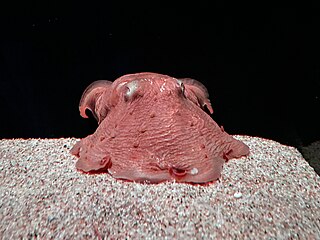
Opisthoteuthis depressa is an octopus found in waters near Japan.

Opisthoteuthis grimaldii is an octopus found near the Azores.
Opisthoteuthis pluto is a deep-sea cirrate octopus found in the Great Australian Bight south of Australia. They live 270–810 m (890–2,660 ft) below the surface in the bathyal zone. Although their habitat is threatened, it is unclear how the species is affected, if at all. O. pluto is named for the Greek and Roman god of the Underworld.












